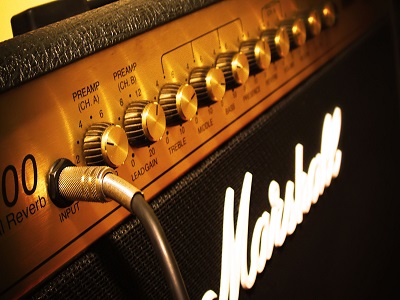3 Steps to Buying a Guitar Amplifier For Your Needs
 Your guitar amplifier is an extremely important part of your arsenal as a guitarist. This equipment is the difference between your electric guitar sounding bad, sounding okay, or sounding great.
Your guitar amplifier is an extremely important part of your arsenal as a guitarist. This equipment is the difference between your electric guitar sounding bad, sounding okay, or sounding great.
So how can you choose the best one for you?
In this article, we’ll walk you through it, step by step.
Step One: Identify Your Goals
What sound are you aiming for?
You know what you want better than anyone else does. Do you want more distortion? Do you want a darker tone or a lighter tone? Do you want digital effects built into your amp, or do you want to set up a pedal board?
While your guitar itself may affect some of these things (different woods produce different tones, different pickups have different properties, and different electronics and their qualities can affect clarity) many of these things will be determined when you purchase an amp.
Step Two: Solid State or Tube?
This is all down to preference.
Tube amps tend to have less gain (depending on the manufacturer, although some can make arguments that Mesa Boogie’s have just as much gain as solid-state amps). Solid State amps tend to have more gain. Tube amps need to have the tubes replaced regularly, usually every couple of years. When changing tubes, all tubes should be changed at once—power tubes and preamp tubes.
Solid state amps have built in guitar effects. They are computerized amplifiers. Whereas a tube amp receives its sound qualities from the tubes, a solid state amp receives its properties from a built in preamp.
Neither amp is better than the other, although there will be hoards of guitarists who will claim otherwise, that one type is inferior to the other. Like with all decisions, it comes down to preference and the golden rule of purchase; you get what you pay for. Cheaper amps won’t be nearly as good as more expensive amps. Unless, of course, you have an ear for different sounds.
Step Three: The Test
Never buy an amplifier without testing it with your own guitar.
This is extremely important, as clips aren’t the best of representations of amps and their overall sound. This is because while the amp clip may be recorded with professional microphones in a studio environment, chances are you won’t be playing in that sort of environment.
Pickups and wood come into the equation as well; the clip could be made using a guitar that is utterly different from your own in every single way possible. This means that the sound you hear in the clip may not be the sound you end up with, and you may wind up very disappointed in the end.
Do your research on the company and its policies. If there are too many discrepancies against a certain company, it may be in your best interest to steer clear. Why? When you have an issue with your amp, you’ll want help, not an “oh well, it’s your problem.”
Follow these three steps and you’ll be on your way to finding the perfect amplifier for yourself and enjoy learning the electric guitar.
The Best Tool For Learning to Play the Guitar
For the ultimate step-by-step guitar system, we highly recommend Gibon’s Learn & Master Guitar course. This award winning DVD course is currently on a 3-day sale and you get to save $100 off the regular price today!
Click here to learn more details and get the course before this promotion ends…







Leave A Comment